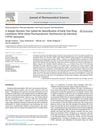Studies on the Disposition of Finasteride: Absorption, Distribution, and Excretion of (14C)finasteride After Single Oral or Intravenous Administration in Rats
January 1994
in “
Yakubutsu dōtai
”

TLDR Finasteride has different absorption and metabolism in male and female rats, with higher concentrations in certain organs and mostly excreted through feces.
This document studies the pharmacokinetics of finasteride in rats, focusing on aspects like bioavailability, absorption site, plasma concentration, radioactivity concentration in tissues, and excretion rates.
Key findings include:
There seems to be a sex difference in plasma metabolite concentrations. In the study, the Area Under the Curve (AUC) of finasteride was 6.73 μg∙hr/ml in female rats, which was about 2.3 times higher than the value of 2.89 μg∙hr/ml for male rats.
The bioavailability (Fpo) was 59% in male rats and slightly higher at 62% in female rats.
Radioactivity was detected in female rats but was below the detection limit, indicating differential absorption and metabolism based on sex.
The study shows that the plasma concentration of finasteride was lesser after intragastric administration compared to other administrations in the gastrointestinal tract. The absorption rates in the small intestine were 26-41% at 15 minutes and 66-71% at 60 minutes.
The highest radioactivity concentrations after administration were found in the stomach, liver, adrenal glands, and the small intestine, which were 11 to 22 times higher than the plasma concentration.
The urinary and fecal excretion rates after oral administration of finasteride were studied, and it was found that around 2.0% of the dose was excreted in the urine and 96.8% in the feces. This excretion was nearly complete 48 hours after administration in both male and female rats.
These findings provide insights into the absorption, distribution, metabolism, and excretion (ADME) of finasteride in rats, which is useful for understanding its potential effects and efficacy.



